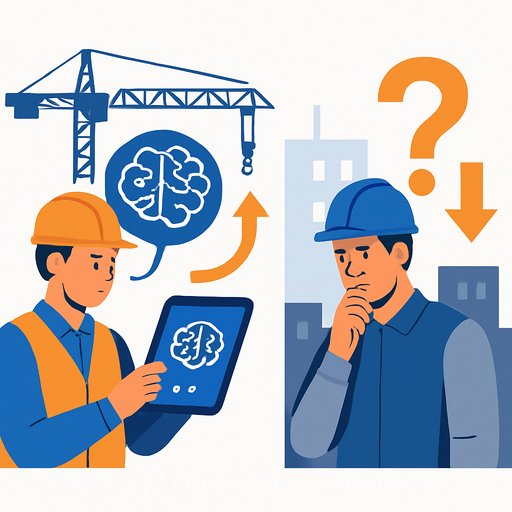Construction AI: The Gap Is Getting Wider
A new global survey of 1,000+ construction leaders commissioned by Currie & Brown shows a split. Most agree AI will matter more over the next five years, yet 1 in 5 do not use it at all. Only 25% regularly apply AI to identify, monitor or mitigate risk on projects.
This isn't a tech problem. It's a mindset problem. The firms moving fastest are already more agile, more proactive, and more confident in delivery.
Key stats at a glance
- 75%+ say AI will grow in importance for construction and infrastructure delivery.
- 25% regularly use AI for risk management; 20% aren't using AI at all.
- Uncertainty as barrier: 48% of non-adopters say it held them back; only 31% think AI can help manage it.
- Uncertainty as catalyst: 49% of regular users say it sped up adoption; 65% say AI helps mitigate uncertainty.
- Top barriers: 40% lack expertise; 39% resistance to change.
- Confidence edge: Over three-quarters of AI adopters are very confident they will hit project goals.
What this means for owners, GC's and PMO leaders
Uncertainty is now a constant. The firms that treat it as a design constraint are pressing ahead and using AI to tighten risk windows and shorten decision cycles. Those waiting for certainty first are falling behind.
As one industry leader put it: "There's a clear paradox. The organisations that most need technology to reduce uncertainty are the least likely to adopt it. That's a risk in itself."
Where adopters are getting value today
- Risk sensing and trend detection across cost, schedule and change orders.
- Proactive quantity, progress and quality variance alerts from site data, photos and reports.
- Contract review and obligations tracking to reduce disputes and delays.
- Scenario planning for materials, logistics and cash flow.
- RFI, submittal and meeting note summarisation with action extraction.
Practical 90-day adoption plan
- Weeks 1-2: Pick one high-friction use case tied to risk or cost (e.g., change-order trend alerts). Define a simple success metric.
- Weeks 3-6: Pilot with real project data. Keep scope tight. Document wins and failure modes. Establish basic data access and permissions.
- Weeks 7-10: Add guardrails: approval steps, audit logs, and model output checks. Train a small cross-functional team.
- Weeks 11-12: Review ROI, decide expand/kill/iterate. If expanding, standardise prompts, workflows and reporting.
Governance that actually helps delivery
- Define what AI can recommend vs. what humans must approve.
- Keep a record of prompts, outputs and decisions for audit and claims support.
- Use accepted frameworks to structure risk controls, such as the NIST AI Risk Management Framework.
Data and tooling basics
- Start with the data you already have: schedules, cost reports, RFIs, submittals, daily logs and photos.
- Use lightweight connectors or exports; don't wait for a perfect data model.
- Combine general AI with construction context. Small, well-structured prompts beat big, vague ones.
People and culture: remove the two biggest blockers
- Lack of expertise (40%): run short, focused enablement sessions on one use case at a time. Make it hands-on, project-specific.
- Resistance to change (39%): measure and share quick wins. Tie AI outputs to fewer surprises, fewer rework loops and faster pay apps.
Metrics that matter
- Variance detected earlier vs. baseline (days saved).
- RFI/submittal cycle time reduction (%).
- Change-order exposure identified pre-issue ($ and count).
- Schedule risk flags converted to mitigations (# and %).
- Claims preparation time reduced (hours).
A simple checklist for your next project
- One AI-enabled risk use case live by week 4.
- Clear human-in-the-loop approvals.
- Prompt templates stored and shared with the team.
- Weekly review of alerts and actions with PMO.
- Documented outcomes feeding into lessons learned.
Upskill your team without slowing the program
If lack of expertise is blocking progress, start with short, targeted learning tied to your next pilot. See role-based options here:
Bottom line
The gap is widening because agile organisations are using AI to manage uncertainty while others wait for it to disappear. Start small, tie AI to real project risks, and build from proven wins. Certainty in delivery is a leadership choice backed by simple, repeatable workflows.
Your membership also unlocks:






